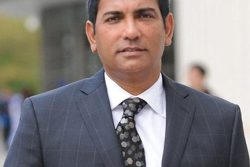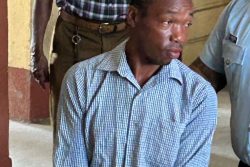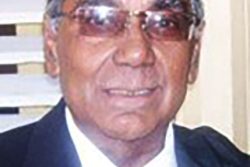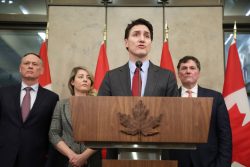There is value in the traditional. Despite my advocacy for more contemporaneity in visual art practice locally (because colloquially speaking we need to shake things up), I do value traditional approaches to art and most definitely training that is steeped in the traditional. What does all this mean? I am simply saying the foundations of a classical art school training cannot be beaten.
Drawing as a starting point: The cube, the pyramid, the oval or sphere tucked away in a corner or an open box to control lighting so that one can see how light falls on the forms more clearly. Hours are spent drawing and shading that oval or sphere, the most troublesome of the trio, so that it appears three-dimensional on the paper. There is drawing from nature; fragments or expanses of nature. I am thinking of a lovely drawing I recently saw in an exhibition of the rocks along the Georgetown Seawall. I don’t remember much else in it. I was distracted. Folks were talking to me as I looked and I was already a bit fatigued by the volume of work I had already seen.
As I looked around the two floors of artwork from the graduating students of the Burrowes School of Arts (BSA), in my head I congratulated them on getting bigger space than the graduates had received last year at the National Museum. I was happy that this cohort was also granted better space – white walls, and improved lighting in an architectural space that offered less distraction to viewing. But, as with last year’s exhibition, I wished more editing had been done – quality over quantity should be the aim.
I identified a few Major Task Projects with one being interestingly ambitious and daring, although not to my liking despite its attempt at a contemporary format. I also saw drawings that should have been part of Year 1 or Year 2 studies; it matters not that the work is dated 2023. As a consequence of having to consider what should not be there or what was not effectively done, my brain was fatigued after one floor. Precious gems like Lucifer as a Musician were being overwhelmed.
Exhibition-making is not just about putting up work for the public to see, ooh and ahh about, and perhaps purchase. Exhibition-making should be about offering the viewer an experience that is complementary to the work. It should be a carefully curated event, and a process in which the height of the average viewer is considered so that explanatory texts do not require bending or tip-toeing to be read and the text is of a readable size and style font, without distracting borders. In being curated, work that lacks strength should be omitted, especially if including it will result in there being inadequate space to allow individual works to be viewed without distractions in the peripheral. If the weaker work must be included, it should not be dominantly displayed. In a group context, balance can be a tricky endeavour. Nonetheless, a group exhibition of varied thematic, technical, and material approaches can be successfully done with careful editing of the constituent parts, allowing adjacent works to be in a harmonious dialogue, and again allowing space to view works.
Since I’ve used the word complementary, it warrants further explanation. A work may be sound in its thematic expression, and its use of the materials and methods but yet not be complementary to the exhibition or adjacent works. I recall about a decade ago, writing the catalogue overview for a two-person exhibition of works being mounted by colleagues. Both had a large body of artwork dealing with familial concerns. One day, as the mounting was ongoing and as I was studying the work crafting a text, the sculpted head of a harpy eagle appeared on a wall. Why?! It was completely incongruous with the human figurative works in the exhibition. Thematically it was a complete divergence, and technically also. I asked for it to be removed from the exhibition with an explanation and it was. This is our perennial dilemma in Guyana – exhibition-making that pays little attention to the viewer experience to allow for thematic harmony (not to be confused with thematic sameness), and visual displays that do not weary the viewer by having multiple discordant pieces. Quality over quantity.
A friend saw some of the BSA graduating student works on social media and asked whether I would write about it. I explained I would not write critically about the works in the exhibition because that is not how I wish to function on this page. I am an artist, not an art critic. (Alas, we need some!) But I will also not engage in reportage. We have had a good bit of that over the years to our community’s detriment. And while I used the recent BSA graduating student exhibition to illustrate my points, the same can be said of many recent exhibitions.
Years ago, the Guyana Women Artist Association (GWAA) fell seriously victim to unevenness and clutter. I was then President of the GWAA. Thankfully, our host made an unequivocal indication that they would not host us again unless we corrected these issues. We called in a local artist not afraid to voice an opinion, an advocate of visual art, and an elder of our association to serve as jurors for our next exhibition. Our jurors were gracious to explain why individual works were rejected. We repeated this process with subsequent exhibitions. Some members appreciated this, others did not. I recall one member pulling her paintings out of the exhibition because one of them was refused by our jurors. Fast forward many years, the dissenting voices now prevail and as a consequence, the GWAA’s recent exhibition in 2022 was a disappointment! A poor inauguration of the beautifully renovated ground floor of our National Gallery of Art.
By now GWAA and the University of Guyana should be preparing for their 2023 exhibitions. Graduating students in the case of the latter and the annual exhibition in the case of the former. Will these exhibitions be approached with care and consideration to strength and optimally showing work or will they be approached with misguided notions about exhibition-making that have not served us well?
Akima McPherson is a multimedia artist, art historian, and educator









